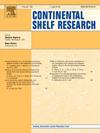模拟加拿大太平洋陆架海床剪应力和沉积物动员的强度和频率
IF 2.2
3区 地球科学
Q2 OCEANOGRAPHY
引用次数: 0
摘要
海洋表面波浪和海流可以相互作用产生强烈的海底剪切应力和沉积物动员,影响基础设施安全和底栖生物栖息地分布。准确了解这些过程对于为确保海洋的可持续发展而作出的决定具有重要意义。利用模拟的3年波浪、潮流和环流数据,建立了一个联合流输沙模型,模拟了加拿大太平洋陆架的海底剪切应力和观测沉积物的动员。并对模拟结果进行了分析,以更新太平洋陆架海底扰动和泥沙运动的框架。大陆架受到强烈海浪和潮流的影响。模拟期间的最大平均有效波高可达3 m,平均近底潮流可达0.6 m s - 1。模拟结果表明,平均波浪和潮流剪切速度分别达到最大值4和3 cm s−1。在模拟的3年期间,在46%的大陆架面积上,观测到的太平洋大陆架上的沉积物可以被潮流至少调动一次,而波浪可以调动47%的大陆架面积上的沉积物,这表明潮汐和波浪的作用几乎相等。此外,波浪和海流相互作用,导致波浪-海流联合剪切速度增强(5 cm s - 1),能够调动超过80%陆架面积的沉积物,几乎是潮汐或海浪单独作用的两倍。然而,基于各组分过程在动员沉积物中相对重要性的空间变化而进行的扰动类型区划表明,以潮汐为主的扰动类型占大陆架面积的43%,而以波浪为主的扰动类型占大陆架面积的32%,表明在太平洋大陆架上潮汐扰动比波浪更重要。混合扰动只发生在很小的11%的陆架面积上。采用海床扰动(SDI)和沉积物流动性(SMI)的通用指数,结合这些过程的强度和频率,更好地量化海底对海洋过程和沉积物流动性的暴露。在大陆架上广泛分布的区域内,模拟剪切应力与观测到的颗粒大小在一定范围内具有很强的偶然性,这表明加拿大太平洋大陆架上的沉积物在很大程度上与当前的水动力学处于平衡状态。模拟床切应力的空间变化及其与观测粒度的相关性,以及模拟沉积物动员和扰动类型的模式,支持并可能改善太平洋大陆架若干地区的地表地质、形态和沉积过程知识。本文章由计算机程序翻译,如有差异,请以英文原文为准。
Modelling intensity and frequency of seabed shear stress and sediment mobilization on the Canadian Pacific Shelf
Ocean surface waves and currents can interact to produce strong seabed shear stress and sediments mobilization affecting infrastructure safety and benthic habitat distribution. An accurate understanding of these processes is important to inform decisions taken to ensure sustainable development of the oceans. Modelled waves, tidal current and circulation current data for a 3-year period were used in a combined-flow sediment transport model to simulate the seabed shear stresses and the mobilization of observed sediments on the Pacific Shelf of Canada. The modelling results are presented and analyzed to update the framework of seabed disturbance and sediment mobility on the Pacific Shelf. The shelf is affected by strong waves and tidal currents. Maximum mean significant wave height over the modelled period can reach 3 m and mean near-bottom tidal currents reach up to 0.6 m s−1. Our modelling results indicate that the mean wave and tidal current shear velocities reach the maximum values of 4 and 3 cm s−1 respectively. Observed sediments on the Pacific Shelf can be mobilized by tidal currents at least once during the modelled 3-year period over 46 % of the shelf area while waves can mobilize sediments over 47 % of the shelf area suggesting nearly equal tidal and wave effects. Furthermore, waves and currents interact to cause enhanced combined wave-current shear velocities >5 cm s−1 that are capable of mobilizing sediments over 80 % of the shelf area, nearly double that due to tides or waves alone. Regionalization of disturbance types based on the spatial variation of the relative importance of component processes in mobilizing sediments, however, demonstrates that tide-dominant disturbance type accounts for 43 % of the shelf area while wave-dominant disturbance accounts for 32 % of the shelf area suggesting tidal disturbance is more important than waves on the Pacific Shelf. Mixed disturbance only occurs over a small 11 % of the shelf area. Universal indices of Seabed Disturbance (SDI) and Sediment Mobility (SMI) were applied to better quantify the exposure of the seabed to oceanographic processes and sediment mobility, incorporating both the magnitude and frequency of these processes. Strong casual correlation between modelled shear stress and observed grain sizes for a range of values and over widely distributed areas on the shelf suggests that sediments are largely in equilibrium with the present-day hydrodynamics on the Pacific Shelf of Canada. The spatial variation of modelled bed shear stress, its correlation with the observed grain size, and patterns of modelled sediment mobilization and disturbance types from our study support and potentially improve the surficial geology, morphology, and sedimentary process knowledge for several regions of the Pacific Shelf.
求助全文
通过发布文献求助,成功后即可免费获取论文全文。
去求助
来源期刊

Continental Shelf Research
地学-海洋学
CiteScore
4.30
自引率
4.30%
发文量
136
审稿时长
6.1 months
期刊介绍:
Continental Shelf Research publishes articles dealing with the biological, chemical, geological and physical oceanography of the shallow marine environment, from coastal and estuarine waters out to the shelf break. The continental shelf is a critical environment within the land-ocean continuum, and many processes, functions and problems in the continental shelf are driven by terrestrial inputs transported through the rivers and estuaries to the coastal and continental shelf areas. Manuscripts that deal with these topics must make a clear link to the continental shelf. Examples of research areas include:
Physical sedimentology and geomorphology
Geochemistry of the coastal ocean (inorganic and organic)
Marine environment and anthropogenic effects
Interaction of physical dynamics with natural and manmade shoreline features
Benthic, phytoplankton and zooplankton ecology
Coastal water and sediment quality, and ecosystem health
Benthic-pelagic coupling (physical and biogeochemical)
Interactions between physical dynamics (waves, currents, mixing, etc.) and biogeochemical cycles
Estuarine, coastal and shelf sea modelling and process studies.
 求助内容:
求助内容: 应助结果提醒方式:
应助结果提醒方式:


